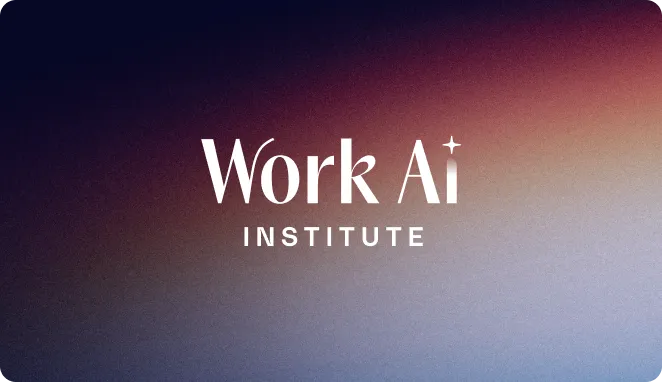- AI is rapidly transforming quick service restaurant (QSR) operations by automating tasks across customer support, employee onboarding, inventory management, and marketing, helping teams work more efficiently and profitably.
- Leading QSR brands like McDonald’s, Wendy’s, and Yum! Brands are already deploying AI tools—such as virtual managers and automated order-taking—to streamline workflows, improve service accuracy, and reduce administrative burdens.
- Platforms like Glean enable restaurants to unify and access information instantly, accelerating onboarding, optimizing inventory, minimizing downtime, and empowering every employee with faster, self-serve answers and smarter decision-making.
Artificial intelligence is no longer a futuristic concept in the restaurant world. It’s already changing how teams work — streamlining operations, reducing costs, and helping staff deliver faster, more consistent service. From back-of-house logistics to customer-facing experiences, AI is becoming an essential part of how modern restaurants operate.
And momentum is building fast. According to Popmenu’s 2025 “Restaurant Trends to Watch”, 74% of restaurant operators expect AI to become a staple in their business within the next three years. Nearly half plan to adopt it within the year. As demand for speed, personalization, and efficiency grows, the pressure to modernize is only increasing.
In this blog, we’ll explore how AI is transforming restaurant operations today — and how platforms like Glean are helping quick service restaurants (QSRs) put AI to work across every team and location.
What is AI for restaurants?
AI is helping restaurants operate with more precision, less friction, and greater impact. It includes a wide range of tools — from inventory forecasting systems to natural language search and generative AI assistants — that are fundamentally changing how teams work.
The goal is straightforward: help restaurants become more efficient, more responsive, and more profitable. By automating repetitive tasks and turning disconnected data into usable insights, AI gives employees the information they need to make smart decisions, faster.
Here are a few key areas where it’s already making a difference:
Customer support
AI assistants can suggest how to resolve incoming tickets, summarize past cases, and draft personalized replies. This helps frontline teams respond quickly and accurately, while reducing the need to escalate issues to other departments.
Employee onboarding
Turnover remains one of the most expensive challenges in the industry. 70% of restaurant operators say openings are hard to fill, and turnover rates above 60% are now the norm. These dynamics contribute to a significant financial burden, with the average restaurant losing around $150,000 each year to employee churn. AI helps lighten the load by giving employees access to information, training, and support without requiring constant oversight from managers or HR.
Inventory optimization
AI can forecast future demand, highlight excess stock, and recommend location-specific actions to prevent waste. These insights help teams maintain better margins and avoid last-minute supply issues.
Marketing and menu planning
Data-powered personalization enables restaurants to target specific customer segments or store locations with tailored promotions and seasonal menu updates. AI can also support campaign execution by helping marketers draft and refine messaging more efficiently.
How AI helps restaurants improve operations and efficiency
Adopting AI can significantly reduce the friction that restaurant teams experience in day-to-day work. Whether you’re running a franchise network or managing a single store, AI systems can help your team move faster and focus on what matters.
For example, AI tools can:
- Predict staffing needs and align schedules with expected demand
- Automate knowledge sharing across departments and locations
- Reduce the time employees spend searching for answers
- Support compliance and streamline updates to SOPs or training content
Restaurants using Glean’s Work AI platform, for example, report saving up to 36 hours per employee on onboarding and reducing internal support requests (IT, HR, etc.) by up to 93% within two years.
What leading QSRs are already doing with AI
AI in restaurants is no longer an experiment. It’s a strategic investment, and many of the world’s most recognized quick service brands are already putting it to work across core operations.
McDonald’s is building a generative AI “virtual manager” designed to take on time-consuming administrative tasks, including shift scheduling. The goal is to give franchisees more time and resources by simplifying workflows and improving efficiency across locations.
Wendy’s is expanding its AI-powered drive-thru system, FreshAI, to 500 to 600 restaurants by the end of 2025. By improving order accuracy and throughput, the system supports faster service and a more consistent customer experience — regardless of whether the restaurant is company-owned or franchised.
Yum! Brands is also scaling its use of AI, with plans to roll out automated order-taking systems to 500 locations by the end of 2025. The initiative is focused on increasing speed and consistency while reducing friction for staff and customers alike.
These examples show that AI is already reshaping the customer journey, employee experience, and franchise operations. Early adopters aren’t waiting to see what’s possible — they’re building it now.
Unlocking profitability through AI-driven insights
One of AI’s most valuable contributions to restaurant operations is its ability to turn fragmented, hard-to-access data into clear, usable intelligence. With visibility across menus, regions, and time periods, restaurant leaders can spot trends early and make faster, more confident decisions.
Modern AI systems help unify data from across the business — such as POS transactions, workforce management platforms, inventory logs, and customer feedback — so operators can:
- Track performance across locations, surfacing what’s working and where changes may be needed.
- Forecast future demand, using historical patterns to plan smarter promotions, purchasing, and labor schedules.
- Respond to real-time changes, like shifting stock between stores or adjusting order quantities based on local activity.
This level of insight supports leaner operations, less waste, and more precise resource allocation. AI doesn’t just enhance reporting — it provides a forward-looking view that helps restaurants stay agile and competitive, even in rapidly shifting conditions.
Why leading QSRs are turning to Glean
Glean is the Work AI platform built to fit seamlessly into how restaurants already operate. It connects to the systems your teams use every day — like HR platforms, POS software, inventory databases, and support tools — and makes the information inside those tools easy to find, understand, and act on.
Whether you're managing thousands of locations or enabling a lean operations team, Glean helps employees across functions get the answers they need, automate everyday tasks, and make better decisions faster.
AI-powered restaurant search for fast answers
Employees can ask natural language questions and instantly get accurate, permission-aware answers from tools like SharePoint, Google Drive, Confluence, and more. Glean eliminates the need to dig through wikis, documents, or Slack threads.
Key use cases:
- Store managers look up the latest menu and promotional campaigns
- HR teams access updated policies or training documentation
- Marketing finds previous campaign assets and brand guidelines
Improve restaurant support with generative AI
Glean enhances support workflows by surfacing relevant content and suggesting responses within tools like Zendesk and Salesforce. It also identifies past cases and uses generative AI to reduce time spent writing replies.
In a commissioned study conducted by Forrester Consulting on behalf of Glean, they found that on average, Glean customers reduced internal support requests across departments like IT and HR by 20%.
Accelerate employee onboarding and training in restaurants
New hires can search for policies, SOPs, and HR details using natural language, making onboarding faster and more consistent. Instead of relying on manager availability, employees can self-serve from day one.
According to the same Forrester study, Glean customers saved an average of 36 hours per employee on onboarding by making essential information instantly accessible.
Use AI to optimize restaurant inventory and reduce waste
Glean helps teams forecast demand, reduce overstock, and shift supplies between stores. With real-time access to inventory data, operators can make smarter purchasing decisions that protect margins and reduce spoilage.
Capabilities include:
- Forecasting based on local demand patterns
- Identifying excess inventory
- Recommending location-level reallocation
Minimize restaurant downtime and improve incident response
Downtime in restaurants can quickly impact revenue and customer trust. Glean gives IT and engineering teams the tools to resolve technical issues faster by:
- Surfacing relevant troubleshooting steps
- Identifying related tickets and logs
- Connecting the right experts across the org
This reduces mean time to resolution (MTTR) and ensures smoother operations across the board.
Increase operational efficiency in restaurant workflows
Glean helps eliminate time lost to context switching and scattered tools. On average, restaurant employees spend 30 minutes per day searching for information. Glean gives that time back.
Glean supports:
- Faster answers to common HR or operations questions
- Self-serve knowledge access for franchisees
- Better day-to-day execution across roles and regions
Practical examples of AI in action at restaurants
AI isn’t limited to one department or use case. It’s making a measurable impact across a variety of roles — from regional leadership to marketing, IT, and franchise support. Here’s how different teams are already putting AI into action.
- Territory managers can quickly look up sales performance, pricing trends, and campaign results by region. With instant access to this data, they’re able to support stores more effectively and make faster decisions without sorting through multiple dashboards.
- Marketing teams use generative AI to create seasonal or localized promotions. By pulling from previous campaign assets, brand guidelines, and performance data, they can deliver relevant, on-brand content without starting from scratch.
- IT teams reduce downtime by enabling self-service access to troubleshooting steps and frequently asked questions. When escalations are needed, engineers can gather context from tickets, documentation, and chat history to resolve issues quickly and limit disruptions.
- Franchisees gain access to centralized portals with policies, training guides, and marketing materials. This helps them stay aligned with corporate standards and reduce the back-and-forth typically required to find the latest resources.
Each of these examples shows how AI can simplify day-to-day work, reduce delays, and enable smarter decisions—without requiring teams to change how they already operate.
The future of restaurant operations is AI-powered
Quick service restaurants aren’t waiting for the future of AI — they’re building it into their operations now. From resolving customer issues faster to optimizing inventory decisions and enabling self-serve onboarding, AI is helping leading brands move faster, cut costs, and scale smarter.
But success doesn’t come from AI alone. It comes from integrating it into the way your teams already work. That’s what makes Glean different. By connecting knowledge across your systems and delivering it in the moment of need, Glean empowers every employee to do their job better — with less friction and more focus.
Ready to see how Glean can help your team unlock the full value of AI? Request a demo and discover what Glean can do for your restaurant business.









